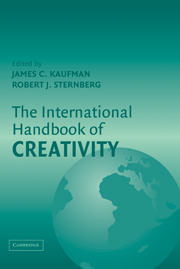Book contents
- Frontmatter
- Contents
- Acknowledgments
- List of Contributors
- 1 Introduction
- 2 Creativity Research in English-Speaking Countries
- 3 Creativity in Latin America
- 4 History of Creativity in Spain
- 5 Past, Present, and Future Perspectives on Creativity in France and French-Speaking Switzerland
- 6 Creativity in Italy
- 7 Creativity Research in German-Speaking Countries
- 8 Creativity Under the Northern Lights
- 9 Creativity in Soviet–Russian Psychology
- 10 Creativity Studies in Poland
- 11 Research on Creativity in Israel
- 12 Creativity in Turkey and Turkish-Speaking Countries
- 13 Development of Creativity Research in Chinese Societies
- 14 Creativity – A Sudden Rising Star in Korea
- 15 Culture and Facets of Creativity
- 16 African Perspectives on Creativity
- 17 Creativity Around the World in 80 Ways … but with One Destination
- Author Index
- Subject Index
1 - Introduction
Published online by Cambridge University Press: 05 June 2012
- Frontmatter
- Contents
- Acknowledgments
- List of Contributors
- 1 Introduction
- 2 Creativity Research in English-Speaking Countries
- 3 Creativity in Latin America
- 4 History of Creativity in Spain
- 5 Past, Present, and Future Perspectives on Creativity in France and French-Speaking Switzerland
- 6 Creativity in Italy
- 7 Creativity Research in German-Speaking Countries
- 8 Creativity Under the Northern Lights
- 9 Creativity in Soviet–Russian Psychology
- 10 Creativity Studies in Poland
- 11 Research on Creativity in Israel
- 12 Creativity in Turkey and Turkish-Speaking Countries
- 13 Development of Creativity Research in Chinese Societies
- 14 Creativity – A Sudden Rising Star in Korea
- 15 Culture and Facets of Creativity
- 16 African Perspectives on Creativity
- 17 Creativity Around the World in 80 Ways … but with One Destination
- Author Index
- Subject Index
Summary
INTRODUCTION
On June 4, 1989, some Chinese students thought they had a creative idea. The idea was of a democratic government in China. The government of the time found their idea to be neither creative nor amusing. Roughly 1,000 students and other protesters were massacred by government forces that day at Tiananmen Square. A government leader who supported the students, Zhao Ziyang, died in January of 2005, shortly before this introduction was written. He had been under house arrest for years, and his death was given short shrift by the Chinese government.
The idea of democracy would be wholly uncreative in the United States, at least as democracy is traditionally thought of. People in the United States would probably say that the idea is lacking in novelty and hence cannot be creative. In some other country, someone having the idea of democracy might be seen as being very creative indeed and at the forefront of new thought about government. Clearly, different countries, or at least their governments, have different ideas about what constitutes creative thought. What does constitute creative thought, and how have people around the world understood and studied creativity?
COMMONALITIES IN CREATIVITY RESEARCH
The goal of this book is to explore theories, research, assessment, and programs for the development of creativity in a wide variety of countries around the world. To this end, we have solicited contributions from authors around the world.
- Type
- Chapter
- Information
- The International Handbook of Creativity , pp. 1 - 9Publisher: Cambridge University PressPrint publication year: 2006
- 24
- Cited by



